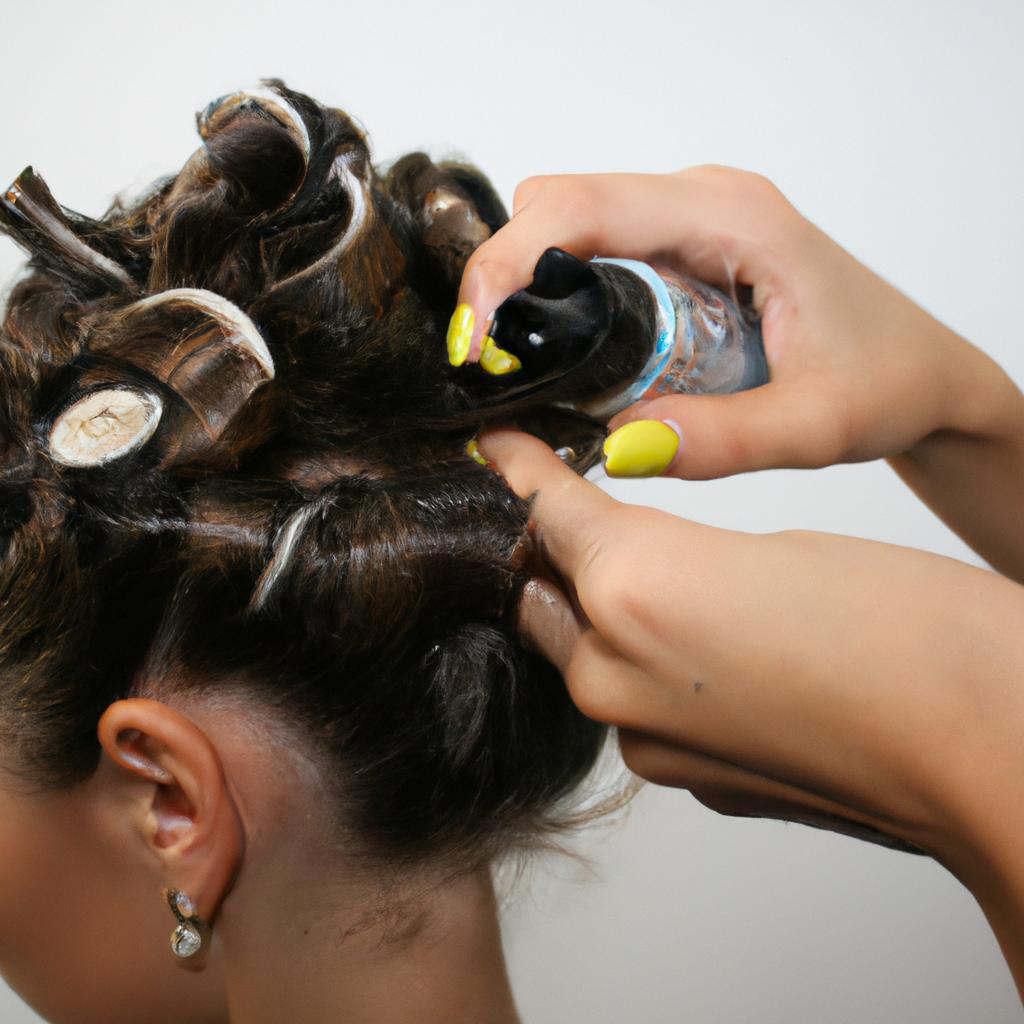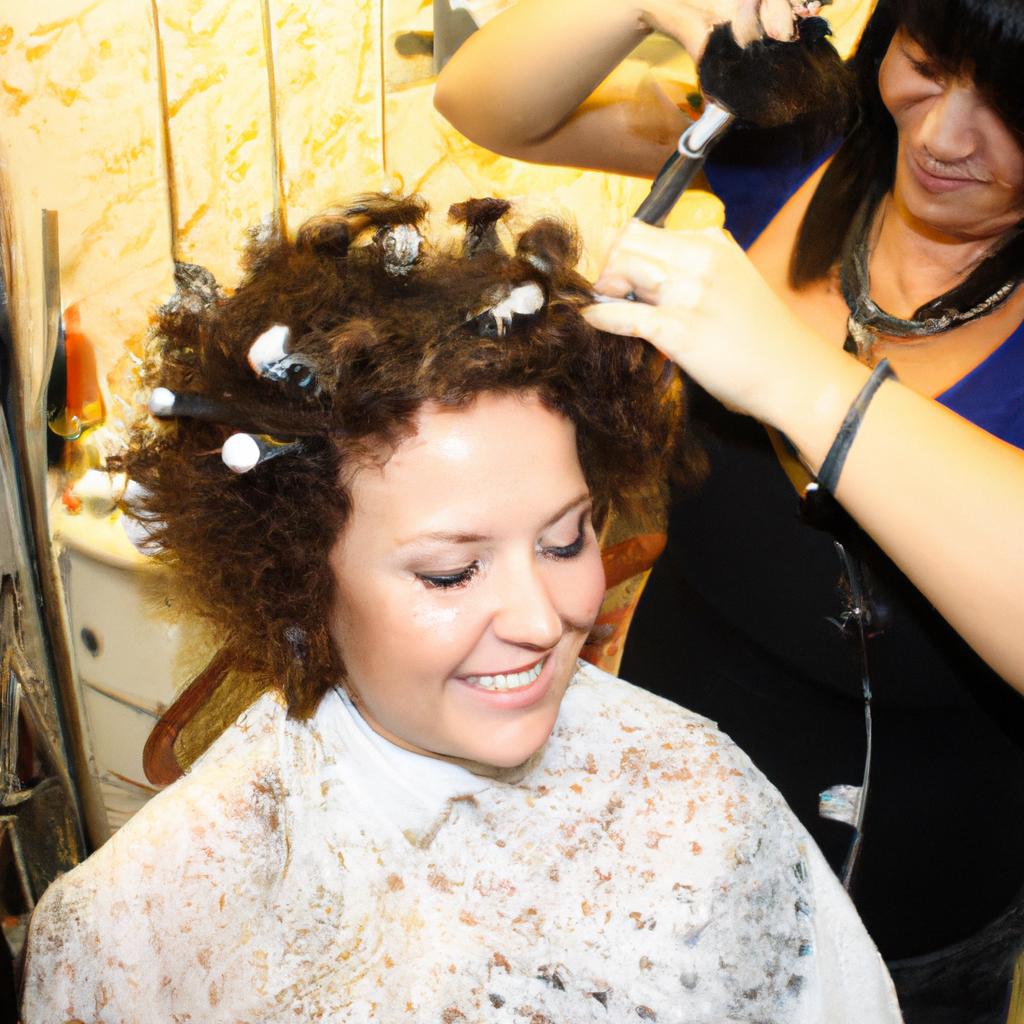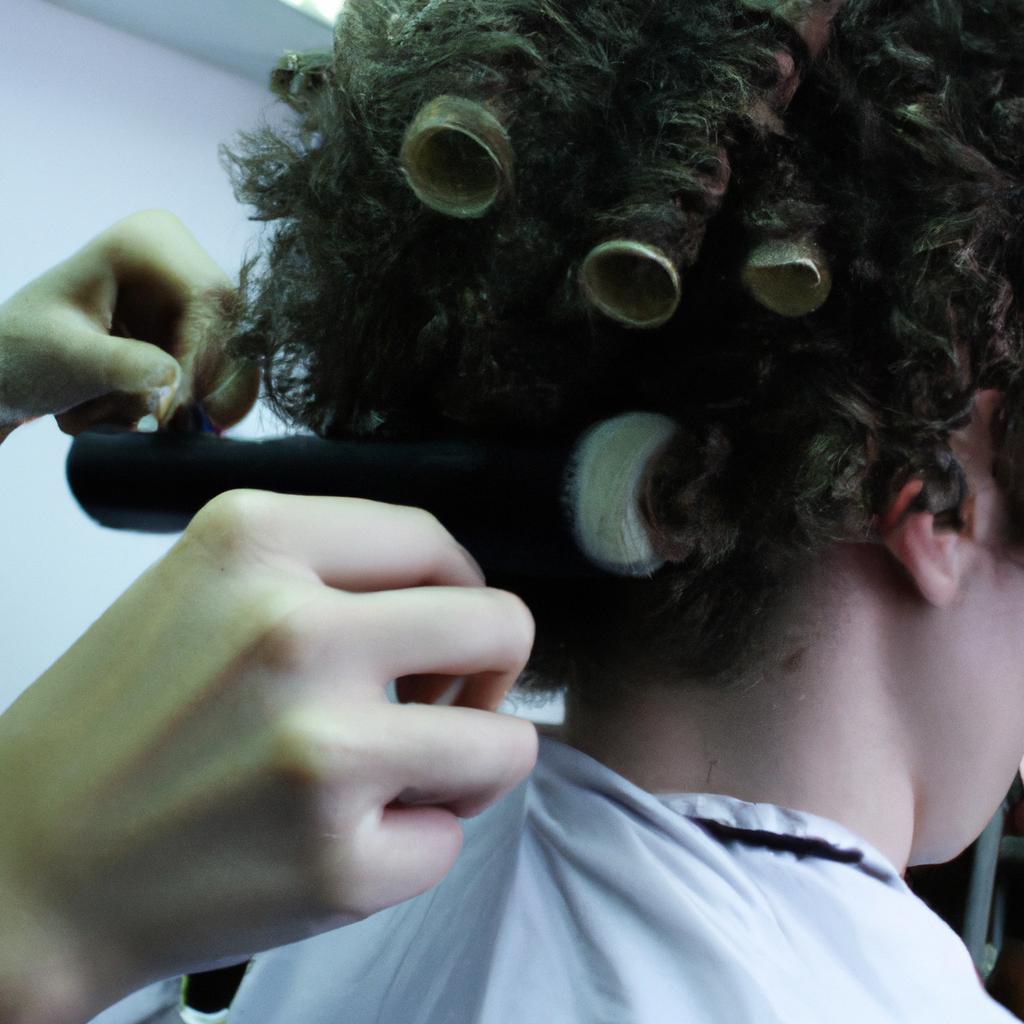Hairdressing salons have long been a hub for individuals seeking to transform their appearance through various hair treatments and styles. Among the many services offered, perm treatments have gained significant popularity over the years. This article aims to provide an in-depth exploration of perms, focusing specifically on the tools and techniques employed by professionals in hairdressing salons.
To illustrate the significance of understanding perm tools and techniques, consider the case of Sarah, a hypothetical client who visits her local hair salon with dreams of achieving luscious curls that will last for months. However, without proper knowledge and expertise regarding perm tools and techniques, Sarah’s desired outcome may remain elusive. Understanding the intricacies of these tools and techniques is crucial not only for clients like Sarah but also for hairstylists themselves as they strive to deliver exceptional results while ensuring minimal damage to their clients’ hair.
Throughout this article, we will delve into the various types of tools utilized during a perm treatment, ranging from rods and rollers to heating devices. Additionally, we will explore different perm techniques such as cold wave perms or digital perms, each offering unique results depending on individual preferences. By gaining insight into these essential aspects of hairdressing salon practices, readers will be equipped with valuable knowledge that can enhance both their salon experience as clients and their expertise as hairstylists.
One of the fundamental tools used in perm treatments is rods or rollers. These cylindrical devices come in various sizes, allowing hairstylists to create different curl patterns based on their clients’ preferences. Smaller rods or rollers produce tighter curls, while larger ones result in looser waves. Understanding the sizing options available and how they translate into specific curl patterns is essential for both hairstylists and clients when discussing desired outcomes.
Heating devices are another crucial aspect of perm treatments. Traditionally, hot perm methods have been widely used, wherein the rods or rollers are heated to activate the chemical solution applied to the hair. However, advancements in technology have introduced alternative options such as cold wave perms or digital perms.
Cold wave perms utilize a chemical solution that does not require external heat application. This method is gentler on the hair, reducing the risk of damage often associated with traditional hot perms. Hairstylists must be well-versed in this technique to offer it as an option for clients seeking a more gentle approach.
Digital perms involve using thermal rods connected to a machine that regulates temperature and timing settings throughout the process. This technique allows for greater control over the size and shape of the curls produced. Understanding how to operate these machines effectively is crucial for hairstylists seeking to provide precise results tailored to their clients’ preferences.
In addition to understanding these various tools and techniques, it is also vital for hairstylists to consider factors such as hair texture, condition, and previous chemical treatments before proceeding with a perm treatment. Conducting thorough consultations with clients helps determine if their hair is suitable for perming and what type of perm would best suit their needs.
Ultimately, by gaining a comprehensive understanding of perm tools and techniques, both clients and hairstylists can navigate through this popular hairdressing service with confidence. Clients like Sarah can achieve their desired looks while minimizing any potential damage to their hair, and hairstylists can deliver exceptional results that leave clients satisfied and eager to return.
Understanding the Perm Process
Imagine a scenario where a client walks into a hairdressing salon hoping to transform her straight, lifeless locks into bouncy curls that will last for months. This transformation is made possible through the process of perming, which involves chemically altering the structure of the hair to create lasting waves or curls. In this section, we will delve into the intricacies of the perm process, exploring its tools and techniques.
To better understand the perm process, it is essential to recognize that it requires careful consideration and expertise from both the stylist and the client. The initial step typically involves an assessment of the client’s hair type, texture, and condition by conducting a thorough consultation. This allows for personalized recommendations tailored to each individual’s unique needs and desires.
Once the consultation is complete, four key factors come into play during the actual perm procedure:
- Chemical Solution: A specially formulated solution containing ingredients such as ammonium thioglycolate and neutralizers is applied to break down and reshape the protein bonds within the hair.
- Processing Time: The length of time required for optimal results depends on various factors like desired curl intensity, hair thickness, and previous chemical treatments.
- Rods or Rollers: These cylindrical tools are used to wrap sections of hair in different patterns before applying the chemical solution. They come in various sizes and materials (e.g., plastic or metal) depending on desired curl size and durability.
- Neutralization: After rinsing out the chemical solution thoroughly, a neutralizer is applied to reformulate new protein bonds in their curled state. It helps stabilize and lock in moisture while ensuring long-lasting results.
Embrace your imagination for a moment with this hypothetical example: picture yourself sitting comfortably in your stylist’s chair as they meticulously apply rods to your freshly washed hair. You feel excited about transforming your appearance but also slightly nervous at what lies ahead. As you sit back with anticipation, here’s a glimpse into the emotional journey that awaits you during the perm process:
- The excitement builds as your stylist explains how they will create natural-looking curls tailored to your preferences.
- A touch of anxiety lingers as you wonder if the chemical solution will work effectively without damaging your hair’s health and integrity.
- An overwhelming sense of relief washes over you when the neutralizer is applied, signaling that the transformation is nearing completion.
- Finally, an exhilarating mix of anticipation and satisfaction fills the air as your stylist removes the rods, revealing beautifully curled tresses.
As we conclude this section on understanding the perm process, let us now shift our focus onto exploring different types of perm tools. By doing so, we can gain further insight into the specific instruments wielded by skilled professionals in their quest to create stunning styles for their clients.
Different Types of Perm Tools
Exploring Perm: Tools and Techniques
In the previous section, we discussed the overall perm process and how it works. Now, let’s delve into the different types of tools and techniques used in hairdressing salons to achieve beautiful permed hairstyles.
To better understand these tools and techniques, let’s consider an example. Imagine a client named Sarah who desires voluminous curls that will last for several months. To achieve this look, her hairstylist would utilize various tools and apply specific techniques tailored to Sarah’s hair type and desired outcome.
When it comes to perm tools, there are several options available in modern hairdressing salons. These include:
- Curling rods: These cylindrical-shaped devices come in various sizes to create different curl patterns.
- Perm papers or end wraps: These thin papers help protect the hair shaft during the perming process.
- Neutralizers: After applying the perm solution, neutralizers are used to stabilize and set the new curl pattern.
- Heat sources: Some stylists may also use heat from hooded dryers or steam machines to speed up the processing time.
Now, let’s explore some common techniques employed by hairstylists during perms:
-
Cold Perm Technique: This technique involves using room temperature solutions without any extra heat application. It is suitable for clients with delicate or damaged hair as it minimizes potential damage caused by excessive heat exposure.
-
Digital Perm Technique: In this technique, hot rollers infused with digital technology are used along with specially formulated solutions. The digitally controlled heat allows precise control over each rod’s temperature, resulting in long-lasting curls that appear more natural.
-
Spiral Perm Technique: As its name suggests, this technique creates spiral-like curls throughout the entire head of hair. Stylists wrap sections of dampened hair around vertical rods starting from near the scalp all the way down to the ends.
-
Stack Perm Technique: With this technique, layers of different-sized curling rods are used to create a stacked effect. This technique adds dimension and movement to the hairstyle, making it ideal for clients who desire more texture.
By understanding these various tools and techniques, hairdressers can personalize the perm process according to their clients’ preferences and needs. In the subsequent section about “Choosing the Right Perm Solution,” we will further explore how selecting the appropriate solution is crucial in achieving desired results.
Choosing the Right Perm Solution
Exploring Perm: Tools and Techniques
In the previous section, we discussed the different types of perm tools commonly used in hairdressing salons. Now let’s delve into the crucial aspect of choosing the right perm solution for achieving desired results.
To better understand this process, consider a hypothetical scenario where a client named Sarah comes to your salon seeking a loose wave perm. As an experienced hairdresser, you carefully assess her hair type and texture before determining which perm solution would be most suitable. By considering factors such as hair thickness, porosity, and elasticity, you can select the appropriate strength and composition of perm solution that will give Sarah the desired outcome while also ensuring minimal damage to her hair.
When selecting a perm solution, it is important to keep in mind various considerations:
- Hair health: Assessing the condition of the client’s hair helps determine if it can withstand chemical processing without excessive damage.
- Desired outcome: Understanding what style or look the client desires allows for customization of the perm solution to achieve their specific goals.
- Maintenance level: Considering how much time and effort the client is willing to invest in maintaining their permed hairstyle ensures they are satisfied with long-term results.
- Stylist expertise: Recognizing your own skill level and experience when working with different types of solutions enables you to choose one that aligns with your proficiency.
Now let’s take a closer look at these considerations through the following table:
| Consideration | Factors to Evaluate |
|---|---|
| Hair Health | – Strength |
| – Elasticity | |
| – Porosity | |
| Desired Outcome | – Loose waves |
| – Defined curls | |
| – Volume | |
| Maintenance Level | – Low |
| – Moderate | |
| – High | |
| Stylist Expertise | – Beginner |
| – Intermediate | |
| – Advanced |
By carefully considering these factors and utilizing the table above, you can confidently select a perm solution that will best suit your client’s needs. Remember, choosing the right perm solution is just one step in achieving a successful perming process.
By following these preparatory measures, you can create an ideal foundation for the perm application process.
Prepping the Hair for a Perm
Transitioning from the previous section, where we discussed selecting the appropriate perm solution, let us now turn our attention to an essential step in achieving a successful perm – prepping the hair. To illustrate this process, consider the case of Sarah, who visited our salon seeking bouncy curls that would add volume to her fine, straight hair.
Preparing the hair for a perm involves several crucial steps:
- Consultation: Prior to starting any chemical treatment, it is imperative to engage in thorough communication with the client. Understanding their desired outcome and assessing whether they have any specific concerns or sensitivities allows us to tailor our approach accordingly.
- Assessing Hair Health: Evaluating the condition of the client’s hair is vital before proceeding with a perm. Factors such as recent color treatments or damage can affect how effectively the hair absorbs chemicals and retains curl. Conducting elasticity tests and examining strands under magnification aid in determining suitability for perming.
- Clarifying Shampoo: Effective removal of product buildup and impurities ensures optimal penetration of perm solutions into each strand. Using a clarifying shampoo helps eliminate excess oils and residue while leaving the hair squeaky clean.
- Sectioning and Protection: Before applying any products or heat sources, dividing the hair into manageable sections safeguards against uneven distribution of chemicals during application. Additionally, protecting sensitive areas such as ears and scalp with barrier cream prevents potential irritation.
To further highlight these critical steps involved in preparing for a perm, let us explore them through an emotional lens:
- Imagine eagerly anticipating your long-awaited makeover at a renowned salon only to be met by a stylist rushing through without asking about your preferences or inspecting your hair health thoroughly.
- Now envision experiencing discomfort due to improper protection measures taken by the stylist, leading to skin irritation and a potentially unpleasant salon experience.
To ensure exceptional service and customer satisfaction, our salon prioritizes each step of the hair preparation process. By paying careful attention to consultation, hair health assessment, clarifying shampooing, and sectioning with protection measures in place, we aim to provide an enjoyable and comfortable environment for our clients as they embark on their perm journey.
Transitioning seamlessly into the subsequent section about applying the perm solution, let us now delve into the next significant stage: achieving those desired curls through precise application techniques.
Applying the Perm Solution
Having properly prepped the hair for a perm, let us now delve into the application of the perm solution. This step is crucial in achieving desired results and requires careful attention to detail.
To demonstrate the importance of applying the perm solution effectively, consider this hypothetical scenario: Sarah, a client with straight hair, desires bouncy curls that will last for several months. The hairstylist carefully sections Sarah’s hair into small segments before proceeding with the perm solution application. By following proper technique and using appropriate tools, such as rods or rollers, the stylist ensures even distribution of the solution throughout each section.
During the process of applying the perm solution, it is essential to keep in mind certain considerations:
- Timing: Different hair types require varying durations for optimal curl formation. It is vital to follow manufacturer guidelines regarding timing to avoid over-processing or under-processing.
- Concentration: The strength of the perm solution should be tailored according to individual needs. A consultation with the client helps determine their desired outcome and select an appropriate concentration level.
- Technique: Whether utilizing a wrapping method or another technique, accuracy and precision are key when applying the perm solution. Each segment must be wrapped securely but not too tightly to allow for proper penetration of chemicals.
- Safety measures: Protecting both clients’ skin and stylists’ hands from potential chemical burns during application is paramount. Using protective gloves and applying barrier cream around sensitive areas minimizes any risk involved.
Table showcasing different concentrations based on hair type:
| Hair Type | Weak (5%) | Normal (7%) | Resistant (10%) |
|---|---|---|---|
| Fine | ✔️ | ||
| Medium | ✔️ | ||
| Coarse | ✔️ |
Bullet point list emphasizing emotional response:
- Achieving perfectly permed curls can boost one’s confidence and transform their overall appearance.
- The anticipation of seeing the final result after applying the perm solution creates a sense of excitement.
- Proper application techniques instill trust in both clients and hairstylists, fostering a positive salon experience.
As we conclude this section on applying the perm solution, it is crucial to note that mastering this step requires practice and expertise. Next, we will explore how to care for permed hair to ensure long-lasting results and maintain its health and vitality. Transitioning into the subsequent section about “Caring for Permed Hair,” let us now delve into essential post-perm considerations.




